COMPOSITIONS
Please find these compositions at theTrevco-Varner Music store--the "World's Foremost Purveyor of Fine Sheet Music for Double Reeds" they even have a composer page just for me!
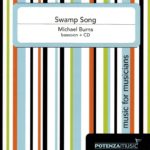 Swamp Song for bassoon and CD. 8’56” The score with accompanying CD are available from Potenza Music
Swamp Song for bassoon and CD. 8’56” The score with accompanying CD are available from Potenza Music
Originally composed at the Electronic Music Studios at Victoria University of Wellington, New Zealand in 1986. This work has been reedited and the accompaniment tape transferred to compact disc for ease of use. It has been very popular and is regularly performed throughout North America and beyond. This work was recorded by Dr. William Dietz, the bassoon professor at the University of Arizona on his CD New Works for Bassoon MJSD 144. All of the sounds on the tape part were originally produced on the bassoon by various means and then electronically filtered and altered. The goal was to blur the lines of separation between the soloist and the accompaniment making it difficult at times to determine which is which. There is a section that features a duet between "normal bassoon sounds that have been electronically altered, on the tape and live 'melodic' multiphonics on the solo bassoon. The similarity of the two sound sources intrigued me and, I believe, provides interest. The piece is also supposed to be fairly light-hearted and fun.
Review:
Bassoonist-composer Michael Burns, has written a fascinating, ca. 10 minute work for bassoon with an electronic music tape for accompaniment. Although decidedly modern, with a few sections in multiphonics, (all carefully fingered for the performer in the appendix), the style is still quite lyrical at times and is not overly disjunct or pointillistic. It is fairly demanding technically, however, ascending to a high e-flat2. It is a strong level IV- in difficulty, demanding a definitely advanced bassoonist. Co-ordination with the tape is carefully indicated in the score generally, but there is a long 44 second section where the composer instructs the performer to: 'improvise - GO WILD! Start frantic and gradually get softer and more spasmodic." Overall, it is a very attractive composition, ending in a lovely lyrical theme, followed by the bassoonist tonguing on the reedless bocal in the bass register, following the gradual fadeout of the taped sounds-nice touch! I strongly recommend this modern-but-accessible new work to the advanced bassoonist for his or her next recital.
Ronald Klimko, The Double Reed, Vol 23 No 2, p. 24.
Review:
This work was originally written in 1986, but has not been published until this year. It has been reviewed in a past Double Reed journal [23 No.2 (2000)], has been recorded by William Dietz on his CD New Works for Bassoon on the White Oak label (BSDW0I) and Dr. Burns just recently put up a youtube video of one of his performances. According to Dr. Burns, all of the sounds on the CD "Were originally produced on the bassoon by various means and then electronically filtered and altered. The goal was to blur the lines of separation between the soloist and the accompaniment, making it difficult at times to determine which is which." It begins with a slow introduction, that is quite lyrical and is similar to a recitative. It then moves into a fast duple meter section, with many svncopations and accents, giving it somewhat of a jazz feel. A return to a slow recit section includes some multiphonics, which are not too difficult to produce. A short return to the fast section then leads into an improvised cadenza, and concludes with another recit section, ending with the bassoonist playing into the bocal without the reed. The most difficult aspect of this work is coordinating with the cd, but overall it is pretty attainable. The range of the bassoon is from Bb 1 to D# 5 and I would give this work a grade of IV-. This is a very fun piece to play and I am sure you and your audience would enjoy this composition.
Daniel Lipori, The Double Reed, Vol 34, No. 2, 2011, p. 143.
Watch a YouTube video of Swamp Song performed live at the Glickman Popkin Bassoon Camp.
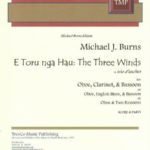 E Toro nga Hau: The Three Winds for reed trio (oboe, clarinet, bassoon). 8'
E Toro nga Hau: The Three Winds for reed trio (oboe, clarinet, bassoon). 8'
This work in two short movements was composed in 2001 and premiered by the EastWind Trio d'Anches (with Burns on bassoon) on a tour to New Zealand and Australia. This has also been performed in Italy, Germany, throughout North America and the South Pacific.
Watch a YouTube video of E Toro nga Hau: The Three Winds with flute instead of oboe, performed live at the Clazz International Music Festival.
E Toro nga Hau: The Three Winds is published by TrevCo Music. TCO 1363 for: oboe, clarinet or english horn or bassoon (1), and bassoon (2)
Double Reed Trio. 8' is a version of E toro Nga Hau for oboe, English horn, and bassoon with appropriate changes to suit the new instrumentation. Premiered at IDRS 2002 in Banff, Alberta Canada by the three co-hosts for the IDRS 2003 conference--Mary Ashley Barret, oboe, James Prodan, English horn, and Michael Burns, bassoon.
There are two additional versions of E Toro:
1. a Trio for Oboe and Two Bassoons, and 2. a Saxophone Trio(SAB)
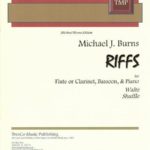 Riffs for flute, bassoon and piano. Ca. 6' this short two-movement work was premiered at the 1998 IDRS Conference in Tempe, AZ with Michael Burns on bassoon and his wife Carla Copeland-Burns on flute. It was inspired by William Dietz, the bassoon professor at the University of Arizona who asked Burns if he could write a sort-of primer piece for jazz bassoon for the non jazz player.
Riffs for flute, bassoon and piano. Ca. 6' this short two-movement work was premiered at the 1998 IDRS Conference in Tempe, AZ with Michael Burns on bassoon and his wife Carla Copeland-Burns on flute. It was inspired by William Dietz, the bassoon professor at the University of Arizona who asked Burns if he could write a sort-of primer piece for jazz bassoon for the non jazz player.
Review:
Bassoonist/Composer Michael burns gives us two delightful, jazzy works here-not overly difficult technically, but a lot of fun to play. The first Riff is a Waltz in 3 and the second a more extensive Shuffle in 4. Written in 9/8 and 12/8, the composer leaves it up to the performer to “make it swing”, which is the primary reason for its level IV- (possibly a III+ to a “jazzer”) rating. The bassoon part only ascends to a high c2, and except for some complicated rhythms and grace notes, is really quite playable. If you are looking for a ‘different’ work for your next recital, this one looks particularly appealing as one that could be lots of fun to play!
Ronald Klimko, The Double Reed, Vol 23 No 2, p. 26.
Listen to MP3 samples of Riffs:
I. Waltz
II. Shuffle
Riffs is published by TrevCo Music. TCO 1356
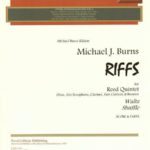 There is also a version of Riffs for Reed Quintet (Ob, Cl, Bass Cl, Bn, Alto Sax) performed at the Shanghai International Arts Festival and on tour in China by the EastWind Ensemble also published by TrevCo as TCO 1369.
There is also a version of Riffs for Reed Quintet (Ob, Cl, Bass Cl, Bn, Alto Sax) performed at the Shanghai International Arts Festival and on tour in China by the EastWind Ensemble also published by TrevCo as TCO 1369.
Eclecticism 1 for Reed Quartet (ob, cl, bn, alto saxophone). 3'47" this brief work was written for, and premiered by the Eastwind Quatour d'Anches in 2002. It is rather typical of my style which eclectically draws from many styles and influences including jazz, serialism, modalism, etc., hence the title. Yes, there will probably be future pieces named Eclecticism 3 and so on :-). Currently unpublished.
Listen to a MP3 sample of Eclecticism I
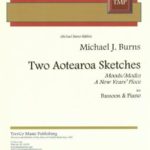 Two Aotearoa Sketches for bassoon and piano. (2004) Ca. 10 minutes. This two-movement work is a fairly substantial reworking and adaptation of two earlier pieces for other solo wind instruments and piano (A New Years' Piece, and Moods/Modes--see below) written while I was majoring in both bassoon and composition at Victoria University of Wellington for my Bachelors' degree. It was premiered at the IDRS 2004 Conference in Melbourne, Australia with Burns on bassoon. The first IDRS conference to be held in Australasia inspired me to write a work that would revisit and present some of my New Zealand music. Aotearoa is the Maori name for New Zealand and is usually translated as “the Land of the Long White Cloud.”
Two Aotearoa Sketches for bassoon and piano. (2004) Ca. 10 minutes. This two-movement work is a fairly substantial reworking and adaptation of two earlier pieces for other solo wind instruments and piano (A New Years' Piece, and Moods/Modes--see below) written while I was majoring in both bassoon and composition at Victoria University of Wellington for my Bachelors' degree. It was premiered at the IDRS 2004 Conference in Melbourne, Australia with Burns on bassoon. The first IDRS conference to be held in Australasia inspired me to write a work that would revisit and present some of my New Zealand music. Aotearoa is the Maori name for New Zealand and is usually translated as “the Land of the Long White Cloud.”
Watch YouTube samples of Two Aotearoa Sketches:
1, Moods/Modes
2, A New Years' Piece
Two Aotearoa Sketches is published by TrevCo Music. TCO 1332
A New Years' Piece for flute and piano. Ca. 6' was composed in 1985 and features a "rippling" piano part somewhat inspired by the first movement of the Saint-Saëns bassoon Sonata. There is also a contrasting, jazzy waltz section in the middle. This has been adapted and reworked to become the second movement of Two Aotearoa Sketches, above. This work received third prize in the Victoria University annual composition competition in 1985.
Moods/Modes for horn and piano. Ca. 4' was composed in 1986 and experiments with the harmonic series of the horn, chords based on open fifths, and extremes of register in the piano while still remaining predominantly melodically conceived. This has been adapted and reworked to become the first movement of Two Aotearoa Sketches, above. A version of Moods/Modes was submitted anonymously under a pseudonym (Lorenzo Lasagne!) orchestrated for horn and orchestra and was runner-up in the Wellington Youth Orchestra Composition Competition in 1987 and was performed by the orchestra and soloist at the Wellington Arts Festival later that year.
Review:
This work, which dates from 2003, is a reworking of two earlier compositions. The first sketch “Moods/Modes” was originally a piece for horn and piano dating from 1986, as “an experiment in the harmonic series of the horn.” It is basically in an ABA form. The first section is slower and has the bassoon outlining part of the harmonic series before moving into the first melody, which alternates between the bassoon and piano. The accompaniment uses many quintal harmonies in the A portion. A few short sections follow before the B material arrives, which is in a moderate dotted half note pulse in a 6/8 meter. Much of the accompaniment in this section has duple against triple rhythms in the piano, while the melody above moves between a duple and triple feel. The entire range of the piano is used, which aids in providing a wide variety of harmonies. The second sketch “A New Years’ Piece” was originally written in 1985 as part of a work for flute and piano, which features a “rippling piano part somewhat inspired by the Saint-Saëns Bassoon Sonata.” As the piano plays the arpeggiated chords, the bassoon enters with a slow, lyrical melody, which moves between duple and triple rhythms. The work then moves into a jazz waltz, which is primarily in three, but has a few other meters thrown in at times. The opening material then returns, and a few variations on this melody occur, including a ‘blues’ section, and a more syncopated area. The bassoon occasionally plays the arpeggiated sixteenth note figure. The bassoon part extends up to c#2 and I would give this work a grade of IV-. There are many different harmonies/colors within this work, which would make for a nice contrast for your recital program.
Daniel Lipori, The Double Reed, Vol. 31, No. 3, p. 120.
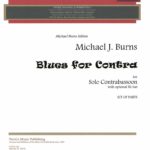 Blues for Contra. (2005) Ca. 4'.
Blues for Contra. (2005) Ca. 4'.
This piece is a reworking and adaptation of an earlier work Blues for Tuba, written for Dennis AsKew in 1998. That work was premiered here at UNCG and then performed at the International Tuba and Euphonium Conference in Sydney, Australia later that year. It wasn’t until 2005 that I thought of rewriting it for solo contrabassoon. Both the Contra and the Tuba are instruments with a very small and limited repertoire although contemporary composers are starting to explore their tonal possibilities more and more. Both are also relegated to their primary roles of playing basslines and being the foundation of a group while hardly ever getting the solo spotlight. This piece partially explores both roles with the player acting as both the ‘walking’ bassline and the solo voice. Some extremes of range are called for all the way down to the low Bb on the contra, the next to lowest note available on most pianos, and up over three octaves to a high B natural. I chose the context of the blues for several reasons: 1. Most of my compositions have at least jazz inflections if not outright stylistic elements, whether it be rhythms, chords, melodic lines, or somesuch, no doubt because of my background as a jazz drummer in my youth. The blues, as an essential element of and precursor to Jazz fits this tendency very well. 2. There is a bit of a back-story for the tuba version as Dennis had an instrument stolen out of a van and then another ‘flattened’ by an accident. So the title of the earlier work has also appeared as Blues for a Stolen Tuba, and Blues for a Flat Tuba. 3. In some respects the blues were chosen as a form of musical protest and statement on behalf of these neglected solo instruments—to paraphrase Rodney Dangerfield, “we don’t get any respect.” 4. Both instruments actually have the potential for a lot of expressive nuances and can inflect the music in quite an evocative manner.
Blues for Contra is published byTrevCo Music. TCO 1329.
Watch a YouTube video of Michael Burns performing Blues for Contra with optional hi-hat at an informal concert at Mack and Mack in Greensboro
Review:
With Blues for Contra, Michael Burns has given us a wonderful new addition to the contrabassoon repertoire. It is an adaptation of Dr. Burns' work Blues for Tuba of 1998, premiered in January 2006 on contrabassoon. It has a catchy melody right from the beginning, which should get the audience's fingers snapping and into the groove presented in this work. It is not an overly difficult work, perhaps about a grade of III for someone familiar with the contrabassoon. The work is about six minutes in length, and the range is just over three octaves, going from low Bb up to a high B natural. There is included a suggested high-hat accompaniment, which I believe could be supplemented with a drum set, or even a double bass. I highly recommend this piece and look forward to performing it soon.
Daniel Lipori, The Double Reed, Vol. 29, No. 3, p. 138
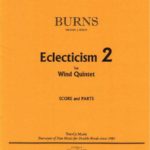 Eclecticism II for Wind Quintet. (2005) Ca. 6'.
Eclecticism II for Wind Quintet. (2005) Ca. 6'.
My compositional style has always tended to combine elements from several diverse compositional schools: jazz, modality, serialism, tonality, etc. Often having more than one of these elements occurring simultaneously. I decided to go with this characteristic and name pieces in a possible ‘eclecticism’ series. Eclecticism I was a reed quartet (oboe, clarinet, bassoon, and alto sax) written in 2001 (see above). This one is the second in the series and in its current form is for the traditional wind quintet (flute, oboe, clarinet, bassoon, and horn.) It also exists in other as yet unplayed versions for true WOODwind quintet (flute, oboe, clarinet, bassoon, and alto sax.), and in a sextet version for reed trio and string trio. Eclecticism II does not share any material with the first eclecticism but acts as a kind of slow movement to counter the faster first. It also certainly does share the diverse collection of techniques, encompassing all of the previously mentioned compositional styles along with an additional contemporary technique involving intervallic expansion and contraction and the age old technique of making the original melody into a bassline which then has a new melody superimposed above it. I would like to express my sincere gratitude to the wonderful players in the student wind quintet Armonia Dolce who worked so hard preparing this piece for the World Premiere.
Eclecticism 2 is published byTrevCo Music. TCO 1331.
Listen to a MP3 sample of Eclecticism II from the World Premiere performance by the Armonia Dolce quintet, 1/31/06.
Review:
This piece is meant to be somewhat of a companion work to Eclecticism 1, for reed quartet (oboe, clarinet, bassoon, and alto saxophone). Though this piece does not share any material with the first eclecticism, it “acts as a kind of slow movement to counter the faster first.” A variety of compositional styles/techniques are used in this work, including jazz, modality, serialism, and intervallic expansion and contraction. The work begins in a slow 6/8 meter with the melody first played in the bassoon, with a chordal accompaniment beneath. The melody is then played by the clarinet, and then oboe, and the pulse sometimes alternates between a duple and triple feel. The work then moves into a 5/8 section where a primarily eighth note melody is presented, with lots of unisons/octaves between the voices. This is followed by a return to 6/8 where the opening melody returns, with a second melody placed over the original tune. The 5/8 material comes back once again, and the work closes with a more homophonic section in 4/4. As hinted at earlier, a wide variety of harmonies/tonalities occur throughout this work, which gives each section a very unique color. The bassoon part extends up to b1 and I would give this work a grade of III+. This work would a great contrast to any quintet program.
Daniel Lipori, The Double Reed, Vol. 31, No. 3, p. 120.
There is also a version of Eclecticism II for Reed Quintet (Ob, Cl, Bass Cl, Bn, Alto Sax)--version 2.6 performed at the Shanghai International Arts festival and on tour in China by the EastWind Ensemble.